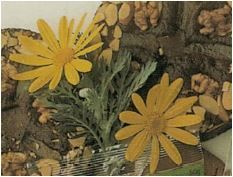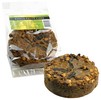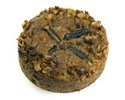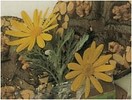Kings Fruit Cake * Seasonal Product *
A mix of apples, kiwi fruit, citrus peel with a pinch of [hard-to-find specialty spices] such as cloves [•], carminative cardamom [••], pineapple [•••] and lemon juice. Mix it all together with stoneground wholegrain silverhull buckwheat/brank flour for an unforgettable, in product, spicery EATRIGHT™ treat!
A source of non-isolate "essential oils (volatile oils, ethereal oils, or essences)…most derived from isoprene and are terpenes at different stages of oxidation” Leung’s encyclopedia of common natural ingredients used in food, drugs, and cosmetics by Ikhlas A. Khan and Ehab A. Abourashed (3rd ed. Pub. 2010). NB. the essential oils are not isolated by “distillation, solvent extraction, or expression” processes.
A great sized 'mini' cake. We pack 'by cake' but we can also pack 'by slice' (ie four slices = one cake). If you want us to pack in slices, please indicate this as your preference in the comments section of your order.
ADDENDA Ingredients: Cert. organic stoneground flours (unhulled silverhull/brank (Fagopyrum esculentum Moench), brown rice), liquid carbohydrate (yeast reduced grape juice (id. 2156-9, 2727), dextrins), pineapple juice (Ananas comosus (L.) Merr (source: bromelin (fruit-bromelin), plant protease, EFSA id. 2212, 2213 “Digestion, Vascular and Vein Health”), cert organic dried fruit mix (apples, kiwi fruit (source: antinidin, plant protease), mixed peel), cert. organic free range eggs, sun dried cert organic mixed mulling spices (id. 2013, 2132, 2649, 2867), cert. organic sunflower oil, cert. organic anionic lemon juice (id. 2028), cert. organic muscovado sugar.
[†] Original Ingredients: Cert. Organic Brown Rice Flour, GOLDen Syrup, Sultanas, Cert. Organic Raw Sugar, Pineapple Juice, Cert. Organic Fresh Eggs, Cert. Organic Sunflower Oil, Freshly Squeezed Spray Free Lemon Juice, Dried Fruit 25% (Prunes, Pineapple), Nuts 10% (Spray Free Walnuts, Flaked Almonds) [*], Spray Free Citrus Peel, Spices (excluded id. 2013 or cinnamon), Raising Agent (Sodium Bicarbonate).
aster, n. Kinds of plant with showy radiated flowers (Gk, = star). asterisk, n. A mark of reference (Gk, = little star). asteraceae, n. Alternatively compositae, commonly referred to as the aster, daisy, sunflower, calendular-marigold family
Uses: Slice it, toast it, share it or eat as is
Shelf life or best before date: 3 Months or more [in a cake tin]. Can be frozen indefinitely (at 0ºC (32ºF) or less) [••••] with shelf life applicability post freezer
Food Safety Verification: Certificate Number 2699 (an International Accreditation NEW ZEALAND (IANZ) third-party inspection body audit, pursuant to the Food Act 2014) issued to Eat Right Food Ltd for the manufacture, processing, exporting, packing, holding and distribution of food products. Where the, independent audit company, is ISO 17020 accredited
Additional Audited Compliance: Australian NEW ZEALAND Food Standards Code 2002; CAFTA Model Recall Procedure: Food Australia, 45(7), 313-316 1993; Codex Alimentarius Commission: Hazard Analysis Critical Control Point (HACCP) System & Guidelines Annex to CAC/RCP 1-1969, Revised 2022; Food Regulations 2015 (LI 2015/310), version July 2023 and Fair Trading Amendment Act 2021
Address: PO Box 1525 [Level 1, 6 Church St], Nelson 7040, NEW ZEALAND
Availability: An EATRIGHT® Online Shop Only Product
Compostable cellophane gusseted, heat-sealed, compost friendly packaging...enjoys a companion mix of micro-organisms, moisture, heat and oxygen
New Zealand Research Relevance: “Worldwide, hookworms infect an estimated 576-740 million people...historically refers to the childhood syndrome of iron deficiency anemia, protein malnutrition, and growth and mental retardation with lethargy resulting from chronic intestinal blood loss secondary to hookworm infection in the face of an iron deficient diet. The increased prevalence of atopy, asthma, and food allergy in areas free of worm infestation has been cited as supportive of the hygiene hypothesis and has even prompted investigation of worms or worm products as therapy for such diseases [†]. It is thought that worm-activated regulatory and counter-regulatory processes involving Th2 and T regulatory cells and cell products may paradoxically inhibit Th2 responses that in the absence of worms cause reactions to potential allergens. Mass chemotherapy remains a mainstay of hookworm control strategies…continued use of drugs may lead to reduced efficacy; treatment failures have been observed" [12]. Hookworm Disease by Author: Darvin Scott Smith MD, MSc, DTM&H et al (updated. Jul’21) emedicine.medscape.com/article/218805-overview (article access via print function only). Where [12] includes ‘a need exists for innovative [petard] approaches'
[†] Innovative approach is www.malaghan.org.nz/our-research/hookworm-therapy/ (nb. impt researchers receive “professional prestige” for future funding) [•••••]
[*] Pharmaceutical treatment estimates $US288-370million/year. Nb, this excludes the cost of adverse reactions or iatrogenic injury
[††] “spices average best medicinally often provably as efficacious as synthetic pharmaceuticals, and almost always safer and cheaper…can preserve us too”. Reductionist’s Rant: Principals of Spice Therapy" by J. Duke, PhD (pub. Dec'11, JAHG). Phenacetin (Gk phainos: shiny) is an example of a synthetic ‘silver bullet’. Yet, its ingestion “can result in a bluish discoloration of the skin due to a lack of oxygen in the blood (cyanosis), dizziness and respiratory depression… reasonably anticipated to be a human carcinogen” (PubChem: 4754). See “the ban on phenacetin..." Australian and New Zealand Journal of Public Health (pub. Aug ’14)
[†††] tin. n. seal up (fruit; meat, &c) in tt. for preservation, t-fish (naut.sl.), torpedo. Pocket Oxford Dictionary, (4th ed. 1952)
Product Details
- Cardamom. “Official in N.F. (National Formulary), F.C.C (Food Chemicals Codex)” Source of anticholinesterase 112,000ppm. Handbook of Medicinal Mints by Beckstrom-Sternberg et al (pub. '00). EFSA ID 2046: “cardamomum SEED” and “kidneys”
- Cinnamon (Cassia): 'significantly increased levels of antioxidant enzymes (catalase, glutathione, glutathione S-transferase (GST) and superoxide dismutase (SOD))' [GST-inducer (limonene), SOD-genic] Leung’s encyclopedia of common natural ingredients by Ikhlas A. Khan et al
- Cinnamon. PhytochemID: Cinnamates. PubMedID: 14585184. …Foods versus the Synthetic Silver Bullet by James Duke, PhD. USDA studies show that cinnamon (ca. 1/8 tsp) can treble insulin efficiency & maybe useful in adult onset diabetes (Khan et al., 1990) EFSA ID 2018 nephroprotective
- Non-tropical Plants Yielding Clinically Useful Drugs. Species: Several other plants [cinnamon: 66ppm(low), 400ppm(high)]. Drug: Benzyl benzoate. Action/Clinical Use: Scabicide. Farnsworth, N. R. & D. D. Soejarto. 1988. Global importance of medicinal plants (unpublished draft manuscript rev. 23)
- Arabinoxylan [from cinnamon] 'reduces blood glucose rise after a meal'. see EU approved health claim, FSANZ deferred
- AGGREGATED cinnamon and cassia...as do spice dealers. But Cassia (Cinnamomum aromaticum, Chinese cinnamon) Indications: Menopause (f. PH2); Cinnamomum verum (Ceylon cinnamon) or Cinnamomum cassia (Cinnamon) Indications: Menopause N/A. Handbook of Medicinal Herbs; Duke, J. A. etc '02.
- Cloves. (Syzygium aromaticum (L.)) Indications: Fever (2; PHR) Physicians' Desk Reference for Herbal Medicine, 1st ed., Fleming, et al. (1998). Feb’rifuge (n. medicine to reduce fever) or possibly Aug'rifuge in the Southern hemisphere?
- Pineapple. Activities - Parasiticide (1; CRC; FNF), Taenicide (1; WO2). Indications - Parasite (1; CRC; FNF), Worm (1; APA; CRC; DAV; PH2). Expels tapeworms Taenia sagiata (beef), T. solium (pork), Diphyllobothrium latum (fish), Echinococcus multilocularis (produce)
- Pineapple ('fruit food farmacy...proteolytic bromelain), GABA or g-aminobutyric acid 124ppm). Indications - Phlebitis (inflammation of a vein) (f; APA) and others. Handbook of Medicinal Herbs, Duke, J. A '02
- Citrus spp. Source of lycopene (ubiquitous: no). PhytochemID: Hesperetin. PubMedID: 18593176. PhytochemID: Narinigin. PubMedID: 17201649. PhytochemID: Tangeretin. PubMedID: 21295043. Ref: Dr. Duke's Phytochemical and Ethnobotanical databases and '...Foods versus the Synthetic Silver Bullet'
- PhytochemID: SILVER. Ubiquitous NO. Antibacterial, antistringent, pesticide. Malus domestica (apple, fruit) 0.011 low ppm; 0.086 high ppm; StdDev -0.5 “Duke, James A. 1992 Handbook of phytochemical constituents of GRAS herbs and other economic plants”. FYI. Silver certificates were a type of representative currency (1878-1964)
- [*] PhytochemID: GOLD Ubiquitous YES. Antiarthritic, antiulcer, nephrotoxic. Juglans nigra (black walnut; seed) --low ppm; 0.001 high ppm; StdDev -0.5; Furr, A.K., et al. 1979. Prunus dulcis (Rosaceae) (almond; seed) --low ppm; 0.001 high ppm; StdDev -0.5; Ref: Duke, James A. 1992
- PhytochemID: TIN. Ubiquitous: YES. Apple; Malus domestica; fruit; 0 high ppm; StdDev -0.37714; Ref: Pedersen, M. 1987. Nutritional Herbology. Pederson Publishing. Bountiful, Utah. 377 pp.
- Biological Activity: antiEBV (Anti Epstein-Barr Virus). Phytochemicals: geranial (IC50=16uM) (sources include: cinnamon, lemon, ginger) and (–)-epicatechin (sources include: apple, grape) Handbook of Medicinal Herbs; Duke, J. A. etc '02.
- Biological Activity: Demulcent [relieving inflammation, irritation]. Pineapple, cinnamon, apple, kiwi, lemon and rice. Dr. Duke's Phytochemical & Ethnobotanical databases (pub. '16)
- Non-isolate salicylates ('therapeutic effects similar to acetaminophen' paracetamol). Bioactivity: anti-inflammatory, anti-platelet-aggregant, uricosuric. Nature sources: pineapple (10-150ppm), cinnamon (150ppm), citrus sp., buckwheat, apple (0.8-60ppm), anise (30-230ppm), vanilla, grape (2-80ppm), ginger (45-250ppm).
- [•] Cloves [Syzygium aromaticum (Myrtaceae)] Chemid: STIGMASTEROL3OBETADGLUCOSIDE Ubiquitous: No.
See also Pfaffia paniculata (Amaranthaceae) and linkage to Suma (hebanthe eriantha) “Handbook of Medicinal Herbs” p705 [in PART-icular] by Duke, J. A et al. (pub. 2002)
- [••] Inhibition of tobacco-induced mutagenesis by eugenol and plant extracts. Sukumaran K, Kuttan R (pub. May'95). Abstract only.
Activities (cardamon): Antimutagenic (1; X7753104); Antinitrosating (1; X7753104). Indications (cardamon): Cancer (1; APA; FNF; JLH; X7753104). Duke, J. A. et al. 2002. Handbook of medicinal herbs
- [•••] Source of non-Ubiquitous plant protease bromelain 800ppm
Duke, James A. 1992. Handbook of phytochemical constituents of GRAS herbs and other economic plants. Boca Raton, FL. CRC Press
- [••••] “The Yale Non-toxic [commercial food storage] Method of Eradicating Book-eating Insects by Deep-freezing”
by Kenneth Nesheim (pub. 1984, authority reqd. pub. Oct’09).
- [•••••] Getting to the Guts of Food Allergy
by Dr Elizabeth Forbes-Blom, Prof Graham Le Gros et al (pub. Nov'12) [ERF draft 12 Mar'14; abbrev. pub. 1 May'14]
- [••••••] “Increase Glutathione-S-Transferase (GST) Activity”
by Duke, James A. 1992. Handbook of phytochemical constituents of GRAS herbs and other economic plants






